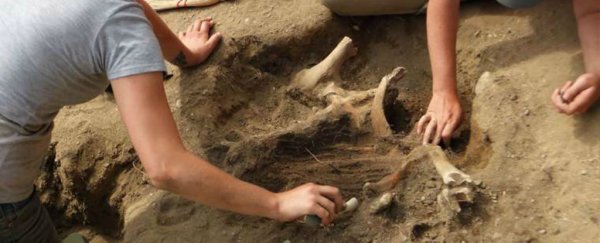Researchers have uncovered the remains of what looks like the original 1620 Plymouth settlement in Massachusetts, where the first pilgrims landed some 395 years ago.
Though the story of the pilgrims and their first Thanksgiving is well-known, the actual settlement where the pilgrims called home has been lost for centuries, making it a highly sought-after site for archaeologists who want to understand more about America's settlers.
Now researchers led by David Landon from the University of Massachusetts, Boston, think they've finally done it, uncovering an ancient settlement with strong evidence linking it to the first pilgrims.
Finding the settlement has taken so long, because the pilgrims didn't use foundations – or bricks at all, actually – so the team had to look for signs of 'post and ground' construction, which are basically holes in the ground where posts once stood.
This means the only signs archaeologists could look for is small holes beneath a pile of dirt that have been worn down for hundreds of years – a frustrating process, to say the least.
The team has been working on the current site for a while now, but it wasn't until recently that they found evidence of post and ground construction that they could link to the pilgrims.
"While we're digging, we're constantly in the process of trying to interpret what we're finding. It really goes to just moving slowly and trying to see if there are any patterns in the flow that we can map out," Landon explains.
"As soon as that starts, it becomes a slow process. It's about much more than the artefacts – it's about trying to pin down soil colour and trying to understand constructed features that are no longer there."
After slowly making their way around the area, the team finally began unearthing artefacts from the era.
Among the first things found were pieces of pottery, tins, beads, and musket balls, but the biggest find came in a rather peculiar form: the skeleton of a calf that the team has named Constance.
This find is particularly important, because Native Americans never held domesticated cattle, which suggests that the researchers were, indeed, digging up a site used by the pilgrims.
 David Landon
David Landon
"Constance is a great symbol of this. Oftentimes success in the colony depended on herds of cattle. It became a centrepiece of the economy. So the calf does connect us to that story," Landon said.
This is some of the most substantial evidence to date to suggest that the first settlement of the pilgrims has been located.
"Finding evidence of colonial activity inside the original 1620 Plymouth settlement is an incredibly exciting discovery that has the potential to change dramatically our understanding of early European colonisation in New England," explains Kathryn Ness, curator at Plimouth Planation, a living history museum dedicated to the Plymouth pilgrims, who partnered with the research team.
"For the first time, we have proof of where the settlement was located and what kinds of items the Pilgrims owned and used."
The team's work has yet to be published in a peer-reviewed journal, so until then, we have to take their word for it. But the next step will be for them to return to the site and see if they can find any more details about those who once lived at the site nearly 400 years ago.
"We've opened the first window but we want a bigger view. We want the bay window. We want to see if we can find other components," Landon said.
With more digging, we might soon know a whole lot more about the pilgrims and how they lived their daily lives in Plymouth, creating a more accurate picture of things like the first Thanksgiving.
